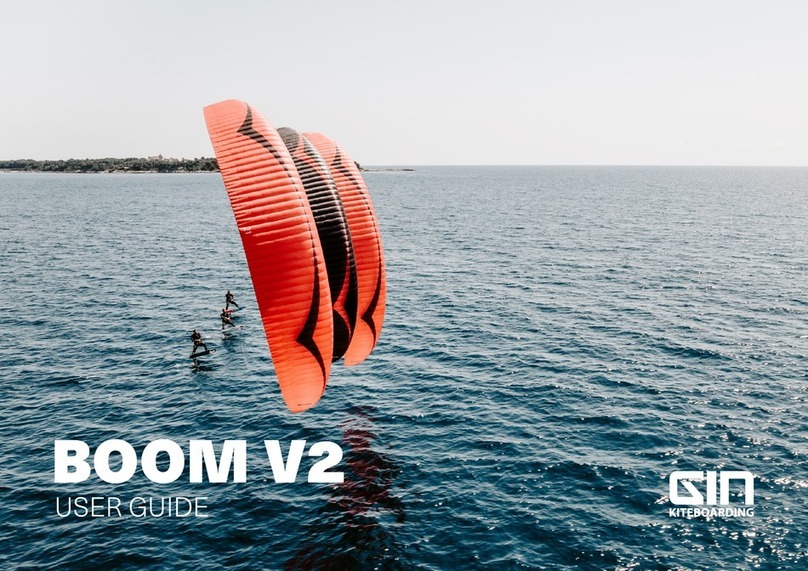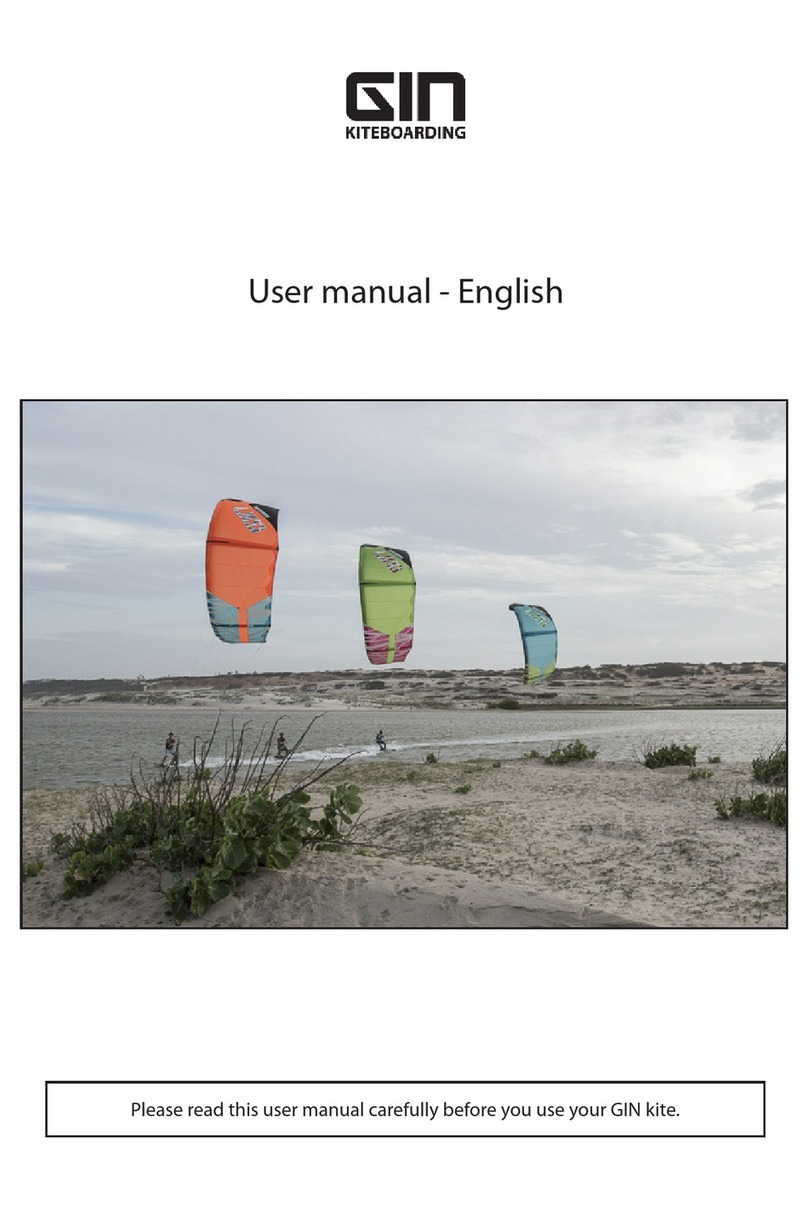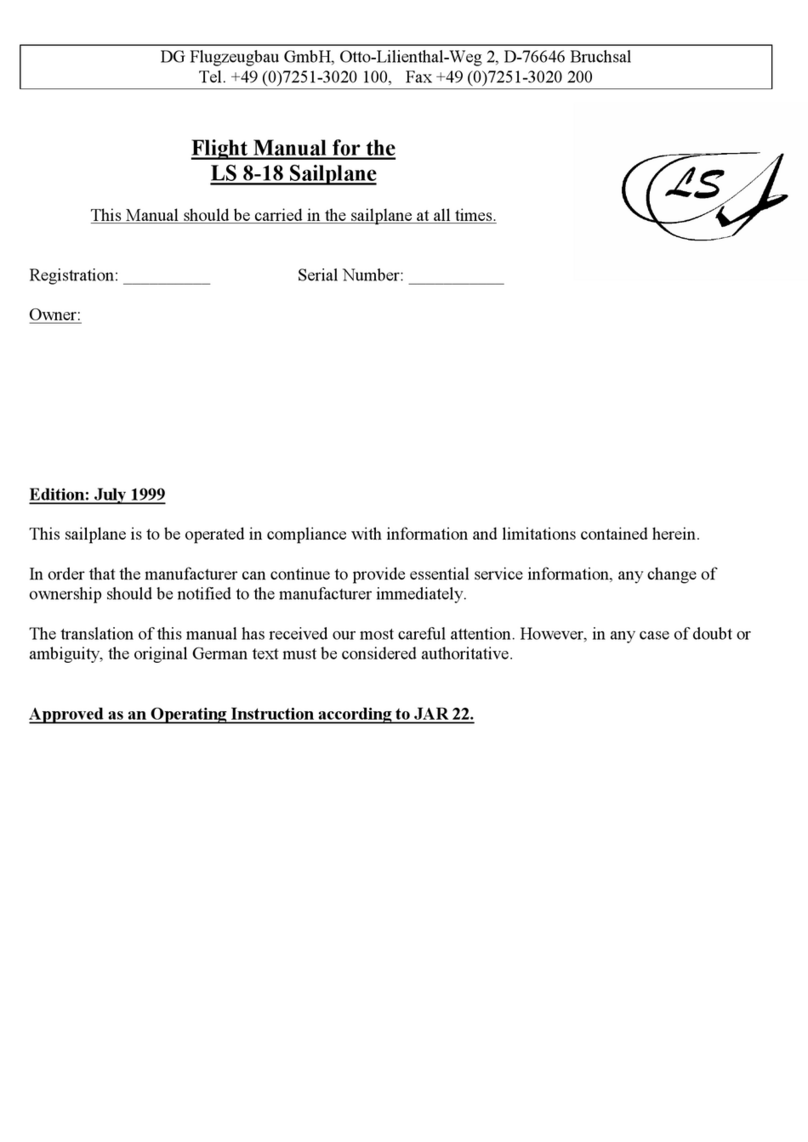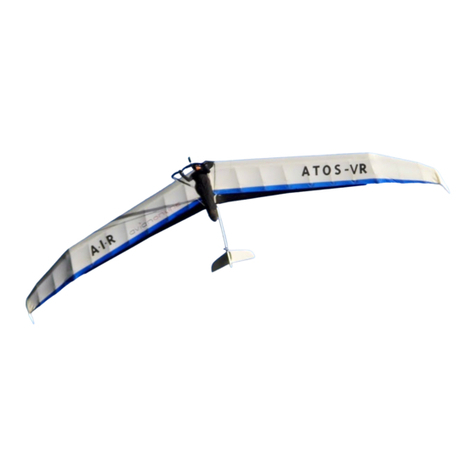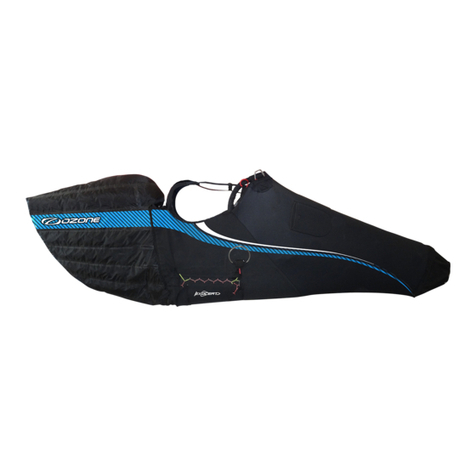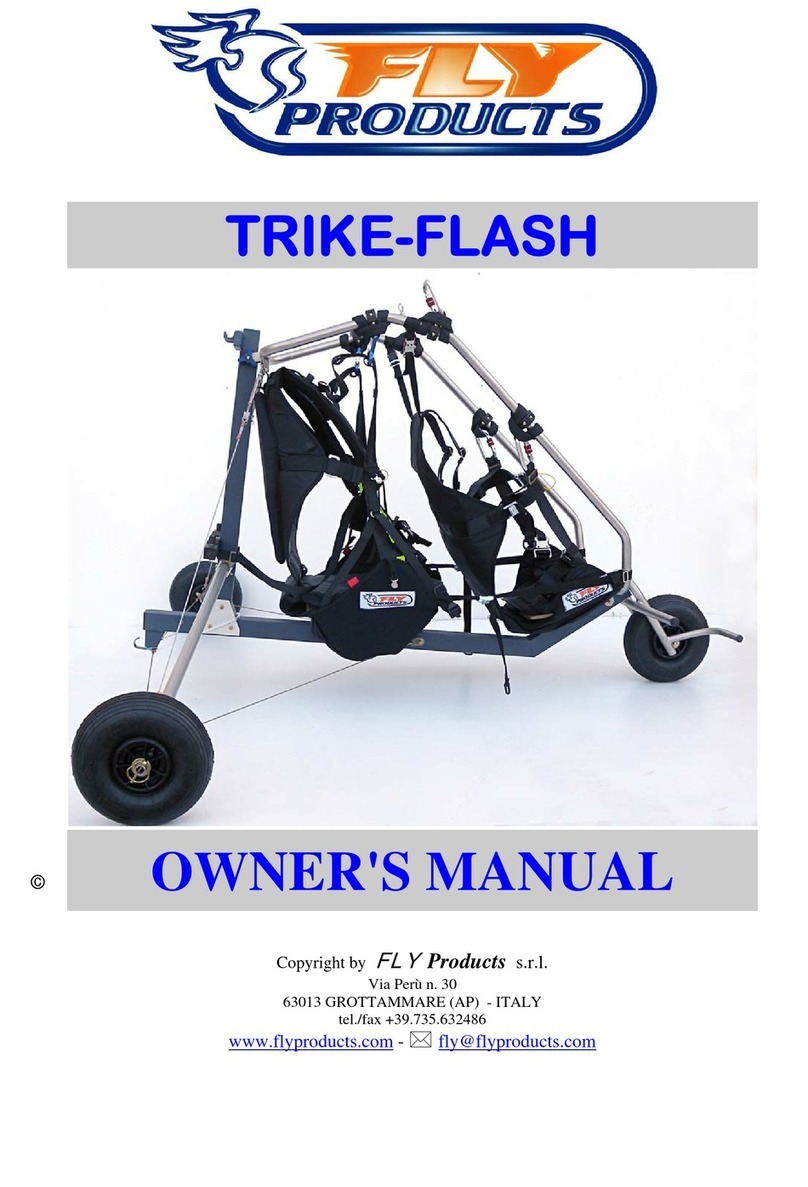GIN Kiteboarding SPIRIT User manual

SPIRIT
USER GUIDE

Wind indicator 11
Taking care of your equipment 21
Warning precautions
Release weaver of claims
3
4
CAUTION
Preparation
Launching
Re-launching
Landing
Packing
Speed system maintenance
12
14
15
16
17
18
FLYING THE SPIRIT
SUMMARY
Rigging closed-cell kites
Rigging the Gin bar
Speed system
Bridle 6m2to 8m2
Bridle 10m2to 18m2
Technical data
5
6
7
8
9
10
CONSTRUCTION

3.
WARNING
PRECAUTIONS
warning
Kiteboarding can be dangerous. Make sure to get professional instructions before you go kitesurng.
Using the product requires you to be responsible for your own as well as others well-being, which includes informing subsequent users/
owners of your equipment about the risks and responsibilities involved. It is possible to suer serious injuries or even death if this product is
used incorrectly.
Safety is not only determined by the safety systems on the kite, but also by proper training, and evaluation of all the circumstances; location,
potential hazards, other people, weather, etc.
Choose a kite size based on your skill level and the wind conditions.
Before you kite, check out the spot. Consider any hazards such as obstacles, shallows, currents, and bans. If an emergency occurs, you need
to know if a rescue craft can reach you.
Never kite near people or obstacles, and always leave at least two line-lengths between you and the downwind line. It is extremely dangerous
to kite near powerlines, roads, airports, clis, etc.
Bars should have emergency release mechanisms that can be opened in an emergency. If you experience an unforeseeable emergency,
you can quickly remove your body from the gear by using a quick-release kite leash.
Lines should only be used correctly to prevent injury to yourself and others. Kite lines can cause severe cuts under tension or even burns if
grabbed by the lines.
Please read this user guide carefully before ying your kite and follow the procedures described. It should be noted that these safety
guidelines are only guidelines and do not claim to cover every possible instance.
For any questions regarding our equipment, please contact your local Gin Partner.
3.

4.
RELEASE
WAIVER OF CLAIMS
By purchasing our equipment, you agree to be a certied
kitesurfer and accept all risks associated with kiteboar-
ding activities, including injury and death. Improper use or
misuse of GIN equipment greatly increases these risks to
the user and to third parties. As a user of the GIN Kiteboar-
ding product, you freely acknowledge and accept that you
and third parties are exposed to known and unknown risks
of injury.
Under no circumstances shall Gin Kiteboarding or its
partners be held liable for personal injuries or third-party
damages. If you have any questions about how to use our
equipment, please contact your local partner.
warning 4.

5.
RIGGING
CLOSED-CELL KITES
plug and play
Leading edge
Trailing edge
Bridles
Speed system
Pulleys
Brakes
Frontline connector
Backline connector
Set up the kite, connect the lines, and enjoy !

6.
plug and play
Set up the kite, connect the lines, and enjoy !
RIGGING
GIN FOIL BAR
Back lines
Front lines
Leader lines
Front line connector
Life line
Depower trim system
Depower line
Holding knots and oats
Quick-release
Pigtails*
For the Spirit, the Gin Foil Bar is recommended. The 52 cm size is for 6 to 10m2, and the 60 cm one is more suitable from 12 to 18m2. In terms of line
length, we recommended using 15m from 6 to 8m2, 17m from 10 to 12m2, and 19m for 15m2.
*Pigtail extensions are available (+2, +2). You can adjust the length of the line according to your needs, support, and convenience.

7.
SPEED SYTEM
GIN SPIRIT
Dynema 3mm / 500kg
CONSTRUCON
A B C
345mm
550mm
250mm
180mm
Loop with nod
Loop
main brake
400mm
565mm
910mm
150mm (red/blue)
Spirit Riser
Total length:
995mm
Total length:
220mm

8.
MAIN - A (LEADING EDGE)
MAIN - B (SECOND ROW)
MAIN - C (THIRD ROW)
MAIN - Br (BRAKES)
23
7
11
18
15
14
19
10
6
14
8
12
17
16
13
20
9
515
9
20
13
16
17
12
8
42
6
10
19
14
15
18
11
7
3
CONSTRUCON
BRIDLE
SPIRIT - 6M to 8M

9.
322 1 1
20
13
11
9
7
5
3
7
8
9
10
11
12
21
13
20
14
19
15
18
16
1717
16
18
15
19
14
21
12
10
8
6
44
5
6
Main-Br
MAIN - A (LEADING EDGE)
MAIN - B (SECOND ROW)
MAIN - C (THIRD ROW)
MAIN - Br (BRAKES)
BRIDLE
SPIRIT - 10M to 15M
CONSTRUCON

10.
TECHNICAL DATA
SIZE 6M2
1KG 1.3KG 1.6KG 2KG 2.5KG
8M2
COLOR
FABRIC WEIGHT
15M2
RATIO
CELLS NUMBER
5,8 5,9 66 6,1
39
GIN SPIRIT
25/+ 11- 27 8 - 23 7 - 20 6 - 18
WIND RANGE TT
WIND RANGE SURF / TIKI
35/+ 20 - 35 20 - 30 18 - 27 15 - 25
30/+ 25 - 35 16 - 26 13 - 23 10 - 20
Wind range are expressed in knots. Wind ranges are provided for your information and vary from rider to rider. It depends on your level, weight and board you
ride (twintip, surfboard, foil, tiki, etc.). Additionally, you should choose your kite based on the weather conditions, the aerodynamic situation and the overall
quality of the spot and its level of safety. You can get an idea of the conditions by checking out the other kites and their sizes.
10M212M2
39 41 41 41
AREA 5,8 7,9 10 12 15
WIND RANGE FOIL

11.
WIND INDICATOR
GIN SPIRIT
FORCE
0
1
2
3
4
5
6
7
8
Calm: smoke rises vertically
Light air
Light breeze
Gentle wind
Moderate wind : leaves in motion, light ags extended
Fresh wind : small trees begin to sway
Sand blows on the beach
White-capped waves
Gale, trouble walking
DESCRIPTION
KNOTS
<1
1-3
4-6
7-10
11-16
17-21
22-27
28-33
34-40
KM/H
<1
1-5
6-11
12-19
20-28
29-38
39-49
50-61
62-74

12.
fly the SPIRIT
Prior to your session, check the conditions (envi-
ronment, direction, area, gusts, gear, ...)
PREPARATION
Lay the kite out 90° to the wind. Fold over the
wingtip and secure it
On the trailing edge side of the kite, place the bar
far enough from all the bridle lines.
Make sure the bridle is free of tangles and pul-
leys out of sand. Connect and test your quick-release system.
Ensure that your ying lines are correctly connec-
ted and that you are clear of any potential risks.
Make sure there are no damages or knots.

13.
PREPARATION
5-POINT CHECK
Is my personnal equipment correct and adapted ?
(Helmet, harness, impact vest, wetsuit, ...)
Is the kite correctly set up and connected ?
Are the lines untangled ?
Does the weather allow for a safe ride ?
Is the launch area clear and safe ?
fly the SPIRIT 13.

14.
Close the deate valve.
LAUNCHING
The kite must be positioned at the edge of the
ying window, generating a small tension on the
lines.
Pre-inate the kite up to half way in the sky, espe-
cially in strong wind. If needed, an assistant can
hold your back in strong wind.
Start pulling up the kite slowly and walking
downwind to the kite.
SELF-LAUNCH
Put the kite up to the zenith and check that every-
thing is correctly set up.
fly the SPIRIT

15.
Grab one back line and pull it towards you so
the kite starts to peel to the side, until the kite
launches at the edge of the wind window.
RE-LAUNCHING
Put your hand back on the bar as soon as the lea-
ding edge of the kite points up.
Ensure that the bar is facing the right way, grab
the back lines and pull. When pulling the back
lines, your kite should reverse.
Your kite should be on one wingspan above the
water, let go of one of the back lines and hold the
other one.
The kite will now rotate. Put your hand back on
the bar as soon as the leading edge of the kite
points up.
ONE-LINE LAUNCH
REVERSE LAUNCH
When pulling up the kite, the drainage
system on the wingtip will ensure the
water ows out of the tip.
fly the SPIRIT

16.
fly the SPIRIT
LANDING
WITH ASSISTANCE
SELF-LANDING
Secure the kite.
Find an assistant to help you land your kite in a
clear area. Use the international signal to instruct
your helper to land the kite by catching the wingtip.
He must be standing at the edge of the window,
upwind of the kite.
After the helper has taken the kite, walk towards
him to release the tension on the lines. The kite
will ag out downwind of the helper.
Secure the kite with some sand or something that
wont damage the kite.
Hold both back lines simultaneously until the kite
stalls and ies backwards. Dont release the back
lines until the kite is fully landed.
Backstalling should only be performed
in light winds

17.
PACKING
YOUR SPIRIT
fly the SPIRIT
Open up the valve.
Roll up the kite around the bar. Ensure that no
sharp objects on the beach damage the fabric.
Fold the kite in half and attach the connection
points on the outside.
Close the deate valve carefully.
Wind the lines around the bar until you get to the
speed system and secure the lines with the elas-
tics or a half hitch. To avoid marks of fold on the
power line, make sure that it is put away unbent.
Grab the downwind wingtip and fold your kite
in half. Ensure that the bridle is securely packed
inside the kite and that the bar never enters or
passes through the bridle lines.

18.
SPEED SYSTEM
The speed system (or mixer) should be replaced as soon as you detect any sign of malfunction or destruction on the pulleys or the lines. The spare part lines and
the pulleys should be replaced after 200 hours of use. Before changing your speed system, make sure you are in a quiet place and sheltered from the wind. Always
change one side at a time and use the other side as a template for how the mixer should look like.
Open the speed system package, check that there are no missing parts (7 pieces), and overlap them with
your old speed system.
Disconnect the front and rear pigtails.
Start by disconnecting the front connection by
removing the loop heads.
Disconnect the rest of the speed system and iden-
tify the parts to be changed. Replace worn parts.
DISASSEMBLY
maintenance
SET UP AND PREPARATION
Lines A, B, C and break must not move!

19.
SPEED SYSTEM
To connect the heads together :
1. Put the 2 lines together.
Make sure all the bridles are clear before connection.
Pass the speed system through the corresponding
pulleys.
2. Pass the main gear head through the other two. 3. Pass through both loops. 4. Apply tension.
maintenance
Make sure there is no twist. Main A has to be
clear from Main B.
REASSEMBLY

20.
SPEED SYSTEM
Before using the Spirit, check that the speed
system and bridles are correct.
maintenance
The line that connects from C to B through the pulley must be the shortest. As shown in the picture,
the connector must be the shortest on B.
RECOMMENDATIONS
Table of contents
Other GIN Kiteboarding Aircraft manuals
Popular Aircraft manuals by other brands
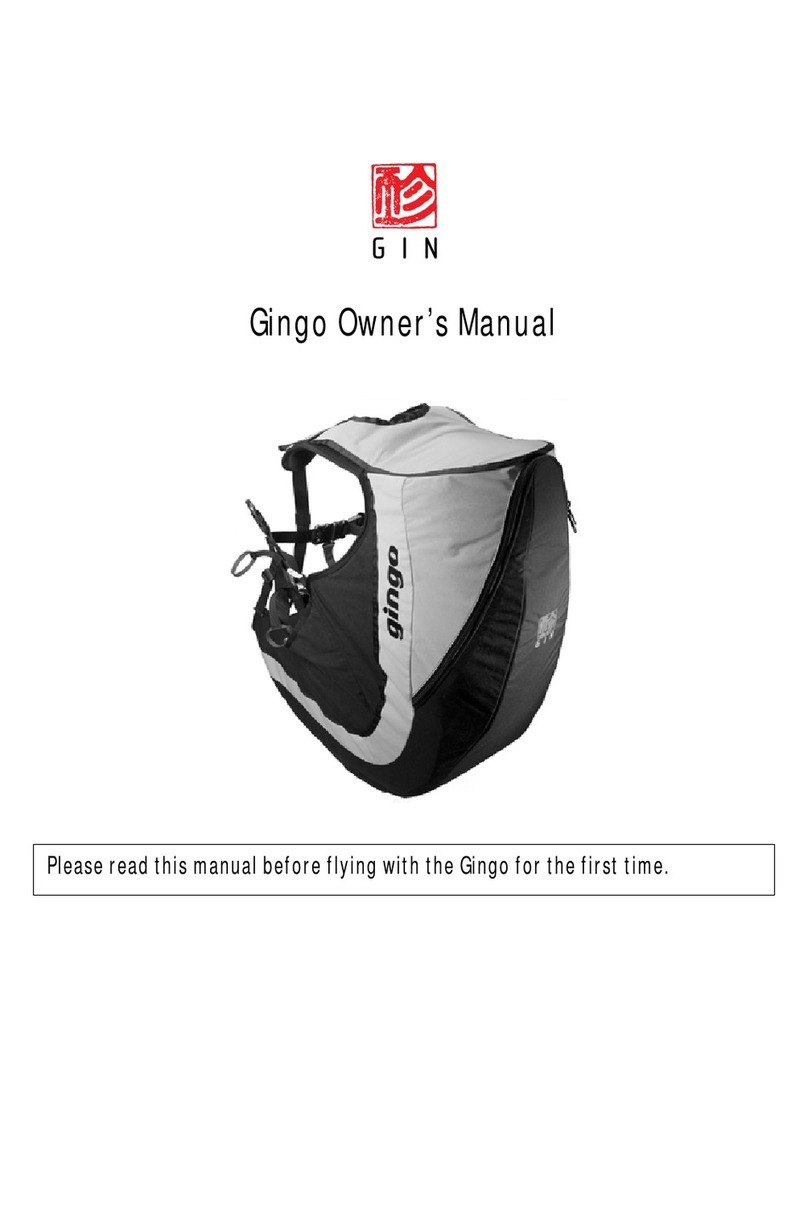
Gin Gliders
Gin Gliders Gingo owner's manual
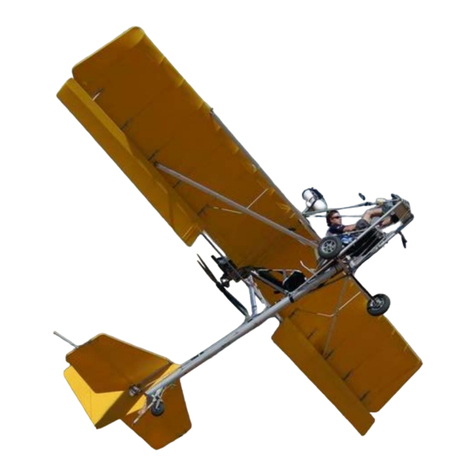
Bailey Moyes
Bailey Moyes 912 Dragonfly Maintenance manual

DG Flugzeugbau
DG Flugzeugbau DG-500 ELAN Orion Flight manual
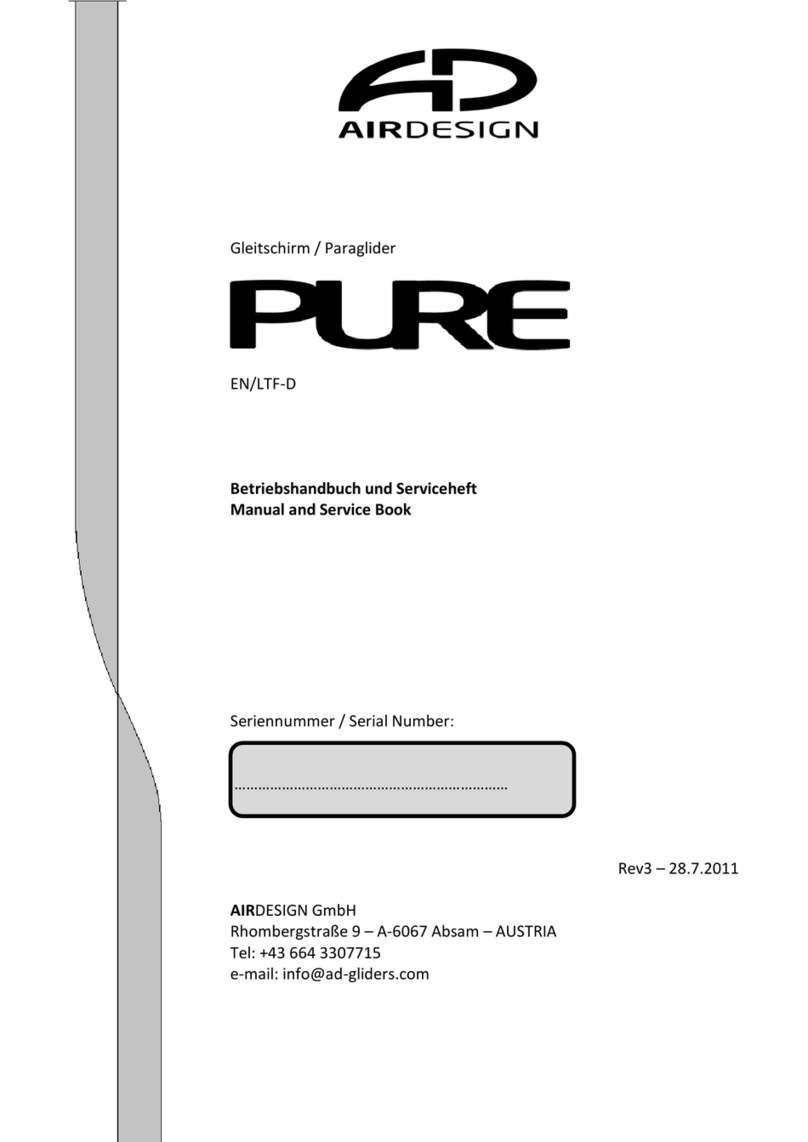
Air Design
Air Design PURE Manual and service book

P.AP. Team
P.AP. Team RM80 user manual
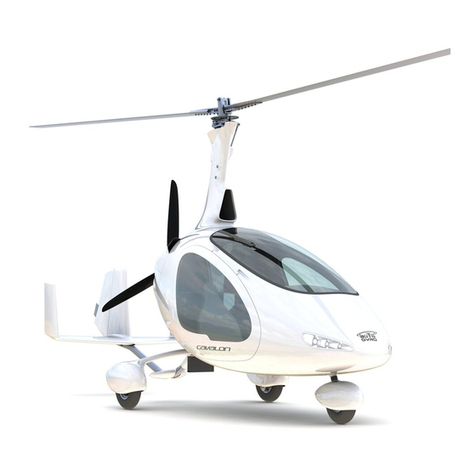
AUTO GYRO
AUTO GYRO CAVALON Manufacturer maintenance manual
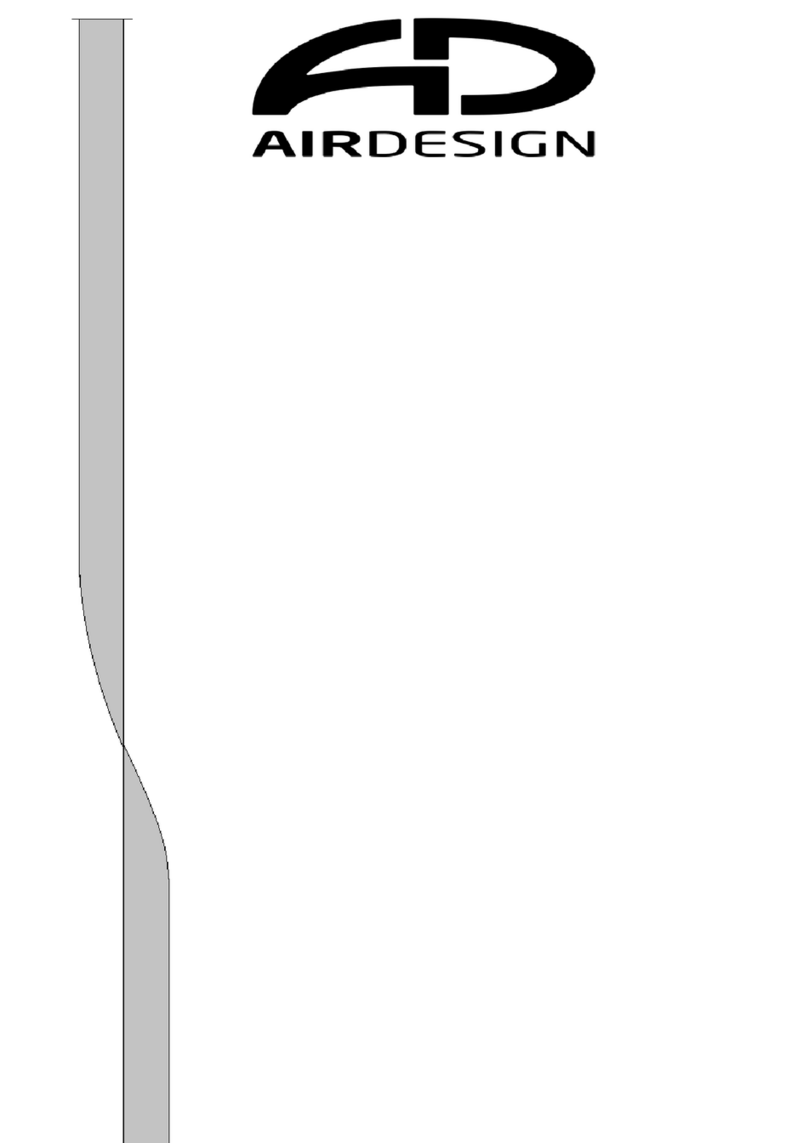
Air Design
Air Design EAZY 2 Manual and service book
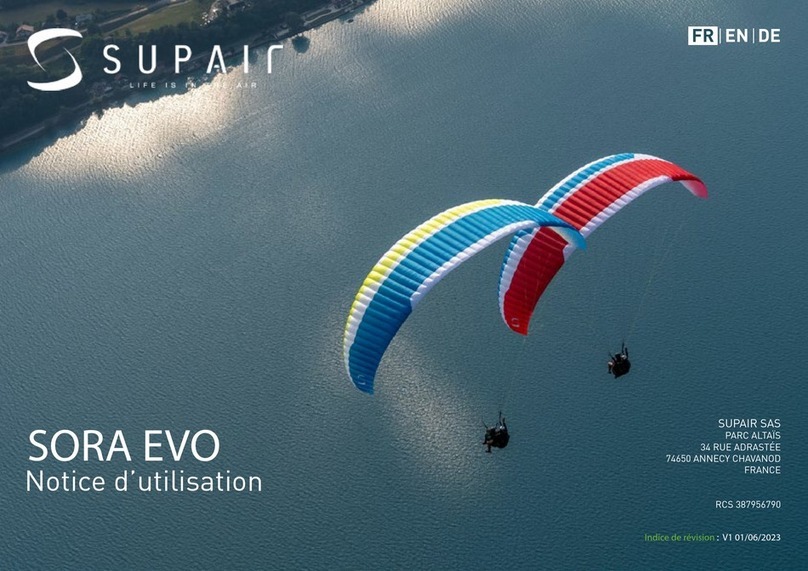
SUP’AIR
SUP’AIR SORA EVO 38 user manual
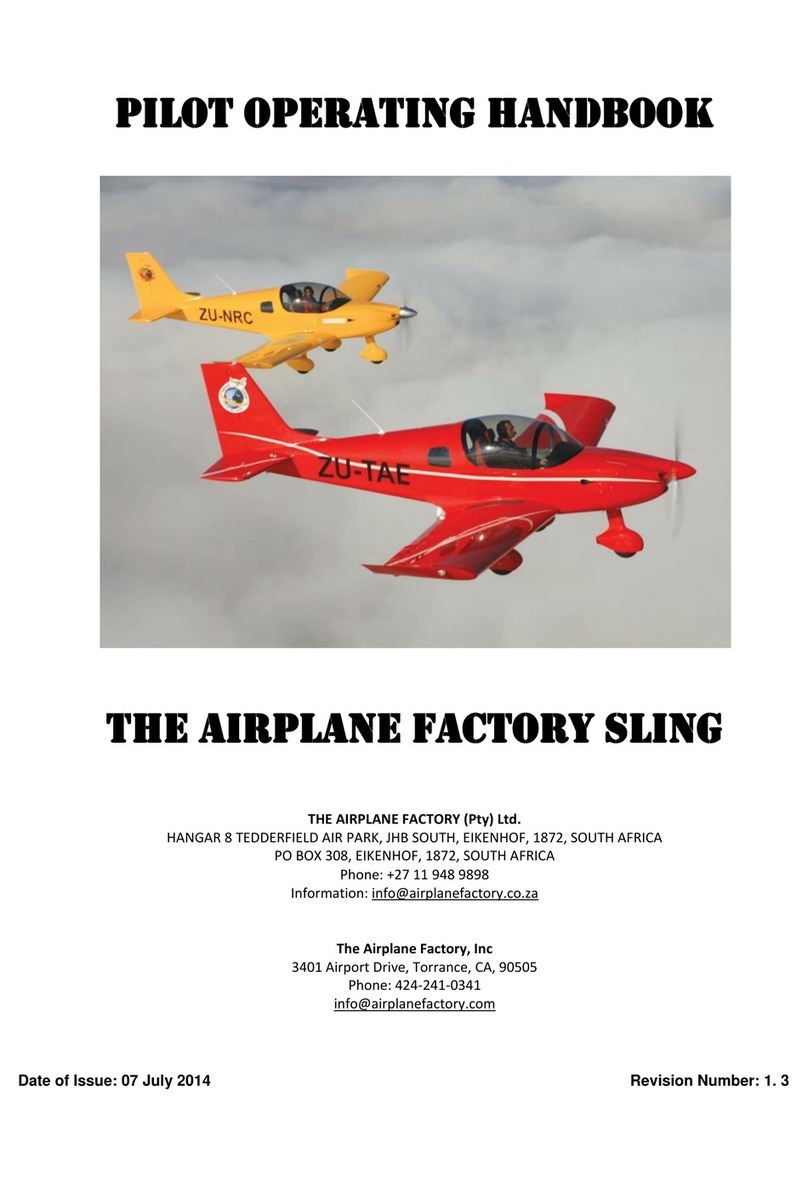
The Airplane Factory
The Airplane Factory ZU-NRC Pilot operating handbook
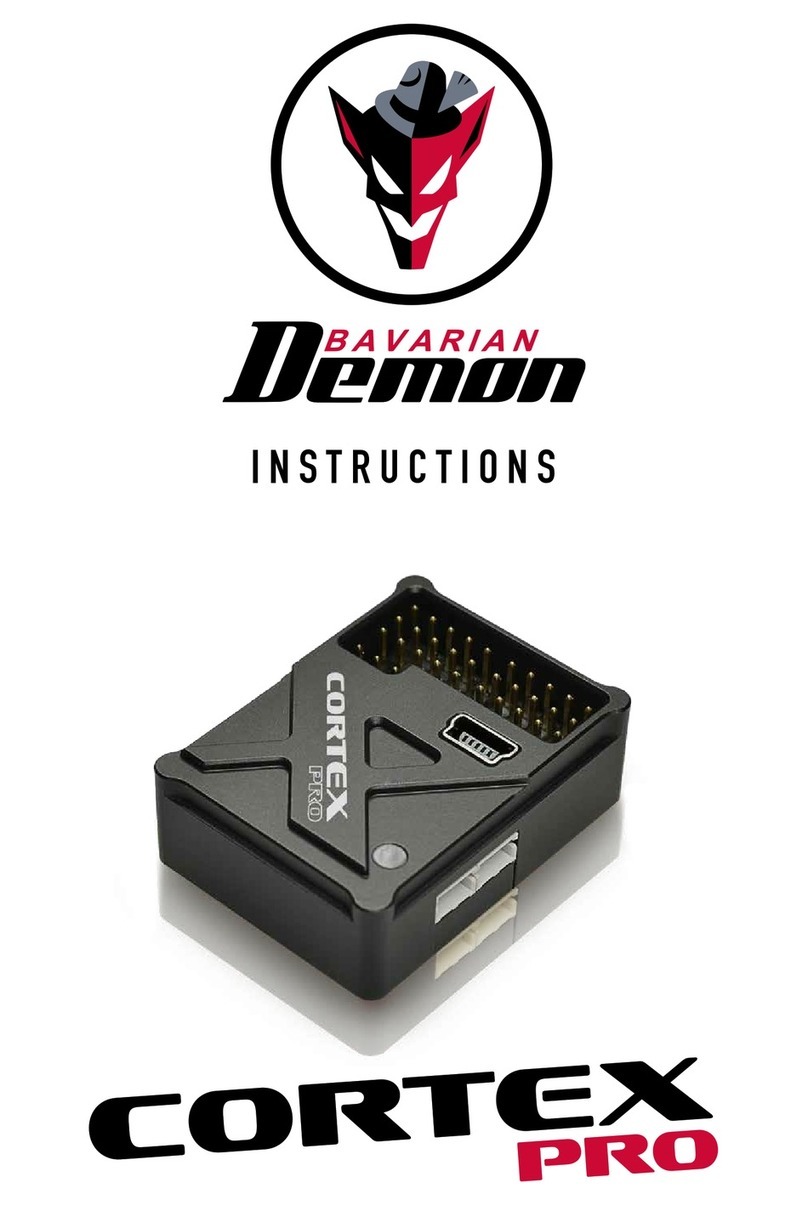
Bavarian Demon
Bavarian Demon CORTEXpro Instruction
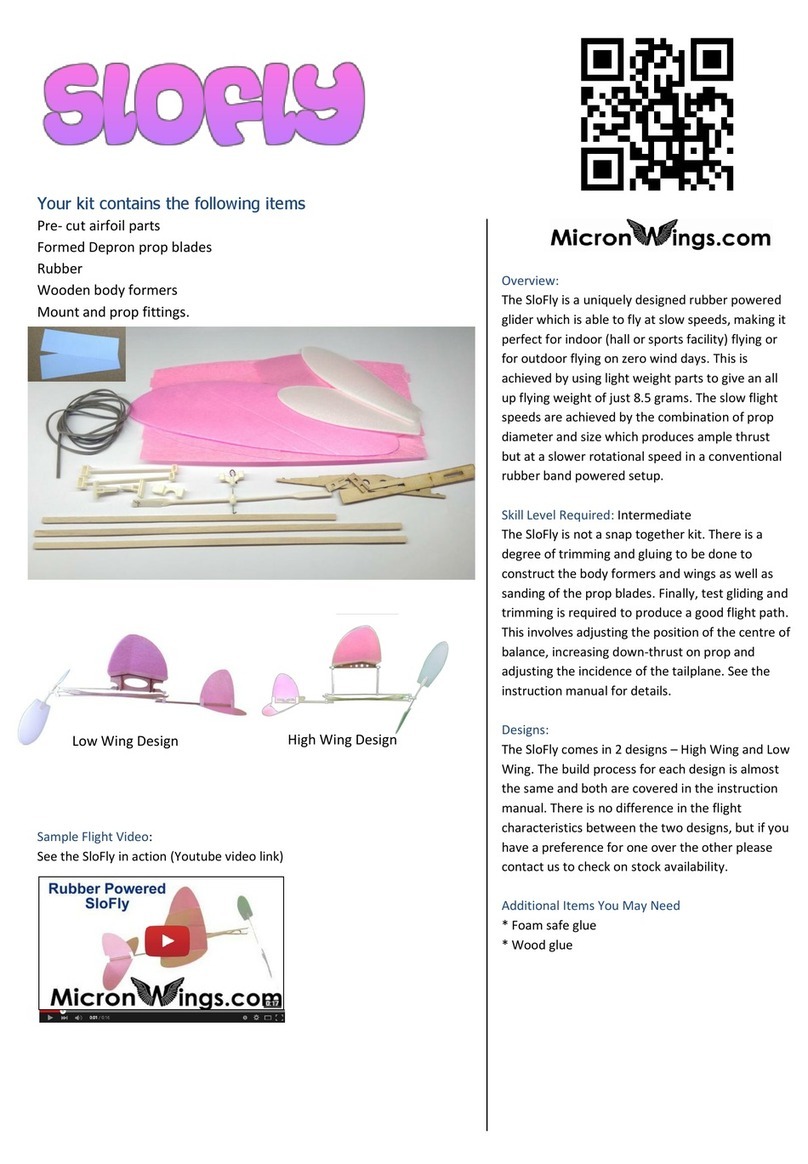
Micron Wings
Micron Wings SloFly manual
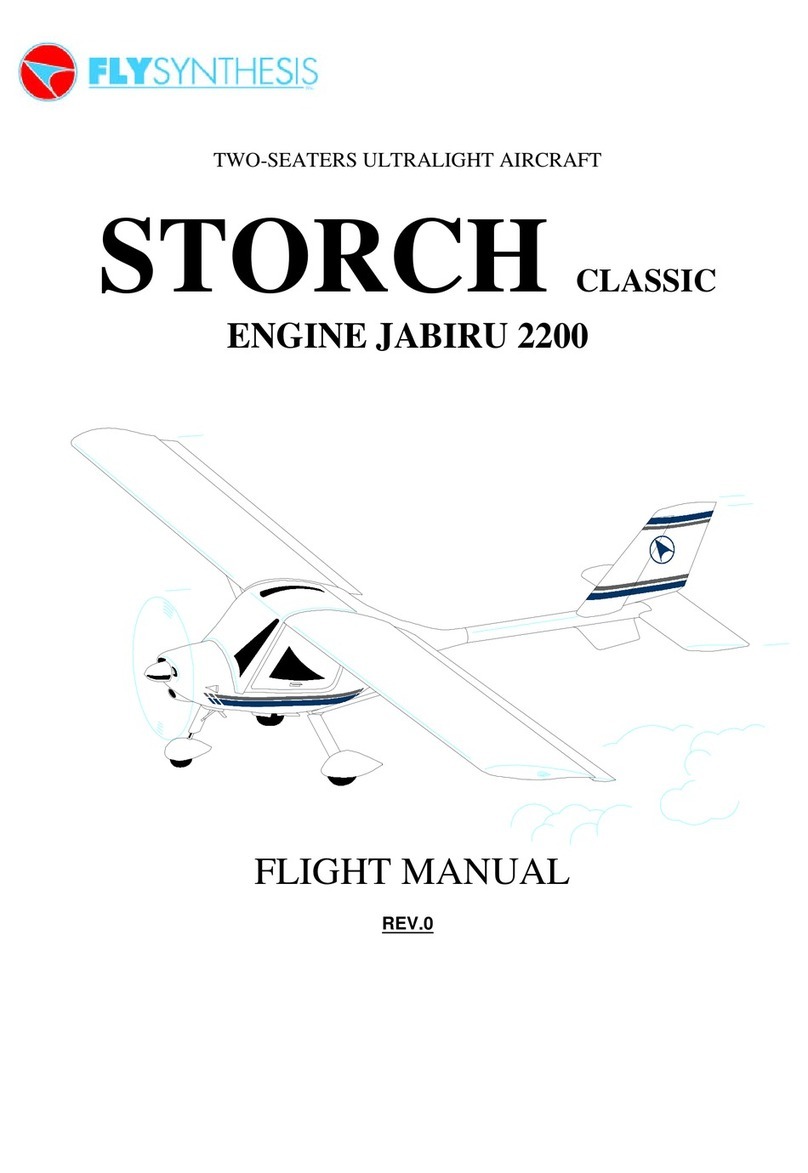
FlySynthesis
FlySynthesis STORCH CLASSIC Flight manual
